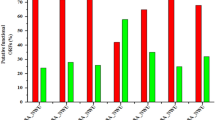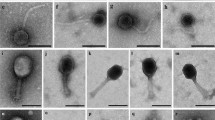Abstract
In this study, we describe the isolation and characterisation of the novel enterobacteria phage CAjan. This phage belongs to the order Caudovirales and the family Siphoviridae. The phage possesses a linear, double-stranded DNA genome consisting of 59,670 bp with a G+C content of 44.7 % and 91 predicted open reading frames (ORFs). Putative functions were assigned to 39 of the ORFs (37.4 %). The phage structural genes were furthermore functionally characterised by LC MS/MS. CAjan, together with Escherichia phage Seurat and Escherichia phage slur01, represent a novel and genetically distinct clade of Siphoviridae phages that could be considered to constitute a new phage genus. Despite limited sequence similarity, the phages in this group share a number of other common features, including genome structure and the presence of queuosine biosynthesis genes.




Similar content being viewed by others
References
Brüssow H, Hendrix RW (2002) Phage genomics. Cell 108:13–16. doi:10.1016/S0092-8674(01)00637-7
Van Zyl LJ, Sunda F, Taylor MP et al (2015) Identification and characterization of a novel Geobacillus thermoglucosidasius bacteriophage, GVE3. Arch Virol 160:2269–2282. doi:10.1007/s00705-015-2497-9
Jardillier L, Bettarel Y, Richardot M et al (2005) Effects of viruses and predators on prokaryotic community composition. Microb Ecol 50:557–569. doi:10.1007/s00248-005-5030-y
Soucy SM, Huang J, Gogarten JP (2015) Horizontal gene transfer: building the web of life. Nat Rev Genet 16:472–482. doi:10.1038/nrg3962
Clokie MR, Millard AD, Letarov AV, Heaphy S (2011) Phages in nature. Bacteriophage 1:31–45. doi:10.4161/bact.1.1.14942
King AMQ, Adams MJ, Lefkowitz EJ (2011) Virus taxonomy: classification and nomenclature of viruses: ninth report of the International Committee on Taxonomy of Viruses. Elsevier
Adriaenssens EM, Edwards R, Nash JHE et al (2015) Integration of genomic and proteomic analyses in the classification of the Siphoviridae family. Virology 477:144–154. doi:10.1016/j.virol.2014.10.016
Bertani G (1951) Studies on lysogenesis. I. The mode of phage liberation by lysogenic Escherichia coli. J Bacteriol 62:293–300
Clokie MRJ, Kropinski A (2009) Bacteriophages: methods and protocols, vol 1. Isolation, characterization, and interactions. Humana Press, New York
Sambrook J (1989) Molecular cloning: a laboratory manual, 2nd edn. Cold Spring Harbor Laboratory, Cold Spring Harbor
Hoyles L, McCartney AL, Neve H et al (2014) Characterization of virus-like particles associated with the human faecal and caecal microbiota. Res Microbiol 165:803–812. doi:10.1016/j.resmic.2014.10.006
Kot W, Vogensen FK, Sørensen SJ, Hansen LH (2014) DPS—a rapid method for genome sequencing of DNA-containing bacteriophages directly from a single plaque. J Virol Methods 196:152–156. doi:10.1016/j.jviromet.2013.10.040
Bankevich A, Nurk S, Antipov D et al (2012) SPAdes: a new genome assembly algorithm and its applications to single-cell sequencing. J Comput Biol 19:455–477. doi:10.1089/cmb.2012.0021
Aziz RK, Bartels D, Best AA et al (2008) The RAST Server: rapid annotations using subsystems technology. BMC Genomics 9:75. doi:10.1186/1471-2164-9-75
Altschul SF, Madden TL, Schäffer AA et al (1997) Gapped BLAST and PSI-BLAST: a new generation of protein database search programs. Nucleic Acids Res 25:3389–3402
Söding J, Biegert A, Lupas AN (2005) The HHpred interactive server for protein homology detection and structure prediction. Nucleic Acids Res 33:W244–W248. doi:10.1093/nar/gki408
Punta M, Coggill PC, Eberhardt RY et al (2012) The Pfam protein families database. Nucleic Acids Res 40:D290–D301. doi:10.1093/nar/gkr1065
Wheeler DL, Church DM, Federhen S et al (2003) Database resources of the National Center for Biotechnology. Nucleic Acids Res 31:28–33
Schattner P, Brooks AN, Lowe TM (2005) The tRNAscan-SE, snoscan and snoGPS web servers for the detection of tRNAs and snoRNAs. Nucleic Acids Res 33:W686–W689. doi:10.1093/nar/gki366
Vesth T, Lagesen K, Acar Ö, Ussery D (2013) CMG-biotools, a free workbench for basic comparative microbial genomics. PLoS One 8:e60120. doi:10.1371/journal.pone.0060120
Hyatt D, Chen G-L, Locascio PF et al (2010) Prodigal: prokaryotic gene recognition and translation initiation site identification. BMC Bioinform 11:119. doi:10.1186/1471-2105-11-119
Turner D, Reynolds D, Seto D, Mahadevan P (2013) CoreGenes3.5: a webserver for the determination of core genes from sets of viral and small bacterial genomes. BMC Res Notes 6:140. doi:10.1186/1756-0500-6-140
Larkin MA, Blackshields G, Brown NP et al (2007) Clustal W and Clustal X version 2.0. Bioinformatics 23:2947–2948. doi:10.1093/bioinformatics/btm404
Tamura K, Stecher G, Peterson D et al (2013) MEGA6: molecular evolutionary genetics analysis version 6.0. Mol Biol Evol 30:2725–2729. doi:10.1093/molbev/mst197
Myers EW, Miller W (1988) Optimal alignments in linear space. Comput Appl Biosci 4:11–17
Kulikov EE, Golomidova AK, Letarova MA et al (2014) Genomic sequencing and biological characteristics of a novel Escherichia coli bacteriophage 9g, a putative representative of a new Siphoviridae genus. Viruses 6:5077–5092. doi:10.3390/v6125077
Rocha EPC, Danchin A (2002) Base composition bias might result from competition for metabolic resources. Trends Genet 18:291–294. doi:10.1016/S0168-9525(02)02690-2
Doan DP, Lessor LE, Hernandez AC, Kuty Everett GF (2015) Complete genome sequence of enterotoxigenic Escherichia coli Siphophage Seurat. Genome Announc. doi:10.1128/genomeA.00044-15
Carstens AB, Kot W, Hansen LH (2015) Complete genome sequences of four novel Escherichia coli bacteriophages belonging to new phage groups. Genome Announc 3:e00741-15. doi:10.1128/genomeA.00741-15
Bailly-Bechet M, Vergassola M, Rocha E (2007) Causes for the intriguing presence of tRNAs in phages. Genome Res 17:1486–1495. doi:10.1101/gr.6649807
Thiaville JJ, Kellner SM, Yuan Y et al (2016) Novel genomic island modifies DNA with 7-deazaguanine derivatives. Proc Natl Acad Sci USA 113:E1452–E1459. doi:10.1073/pnas.1518570113
Author information
Authors and Affiliations
Corresponding author
Ethics declarations
This work was funded by Lundbeck grant R44-A4384 and a PHAGEMID project financed by the Danish Research Council for Technology and Production (4093-00198). All the authors declare no conflict of interest. This article does not contain any studies with human participants or animals performed by any of the authors.
Additional information
A. B. Carstens and W. Kot contributed equally to this work.
Rights and permissions
About this article
Cite this article
Carstens, A.B., Kot, W., Lametsch, R. et al. Characterisation of a novel enterobacteria phage, CAjan, isolated from rat faeces. Arch Virol 161, 2219–2226 (2016). https://doi.org/10.1007/s00705-016-2901-0
Received:
Accepted:
Published:
Issue Date:
DOI: https://doi.org/10.1007/s00705-016-2901-0




